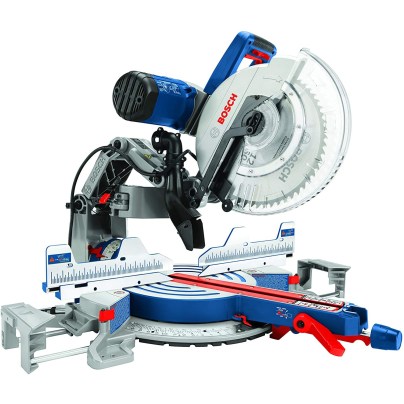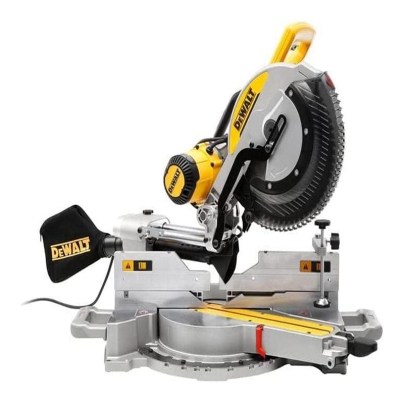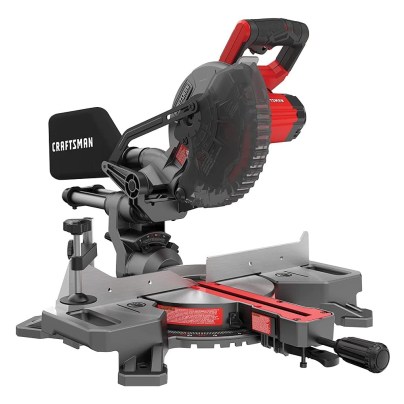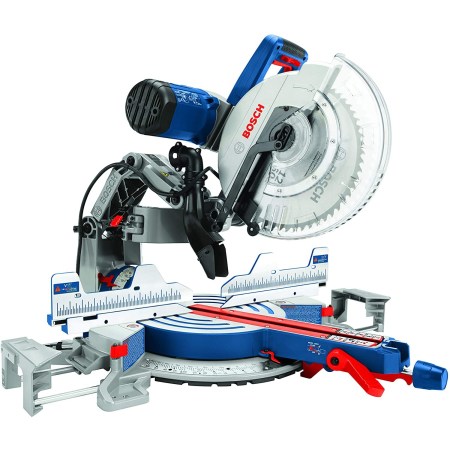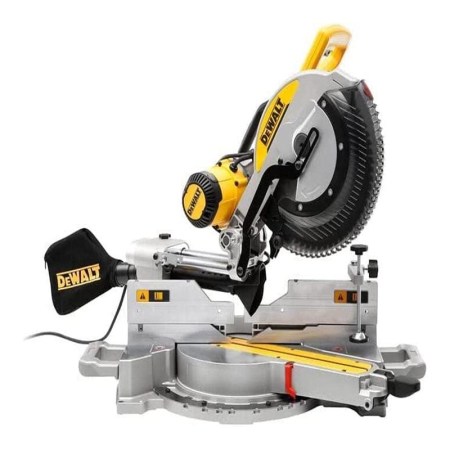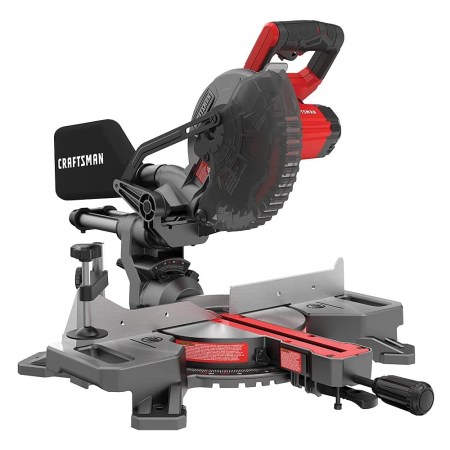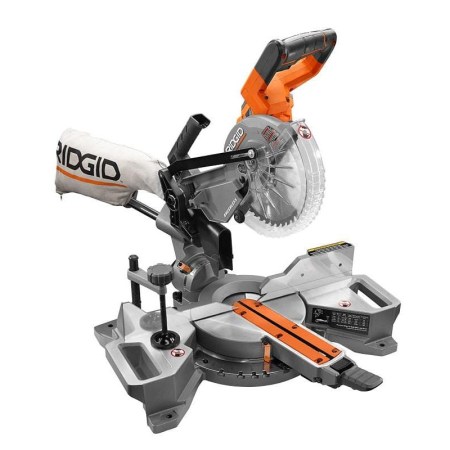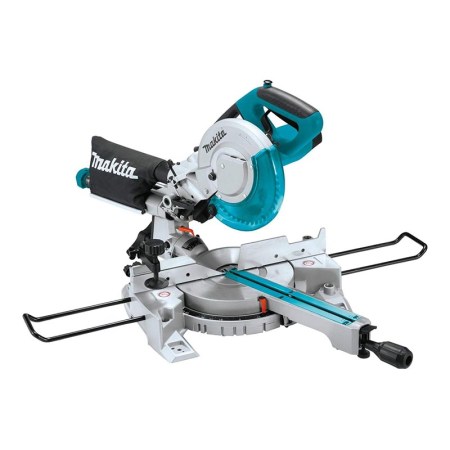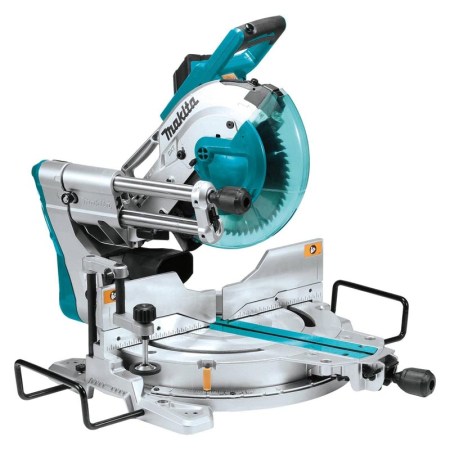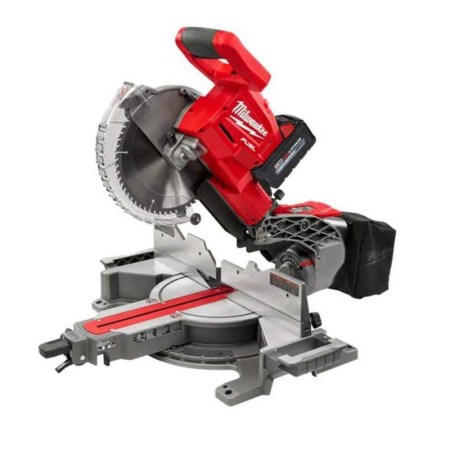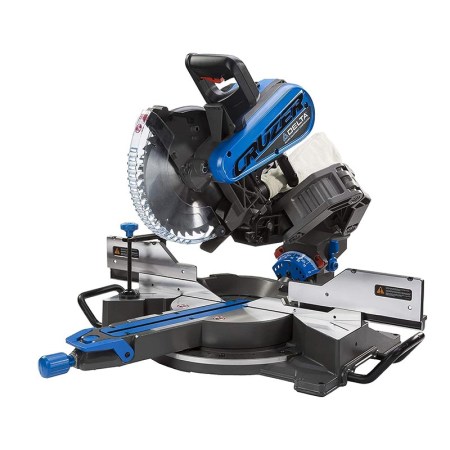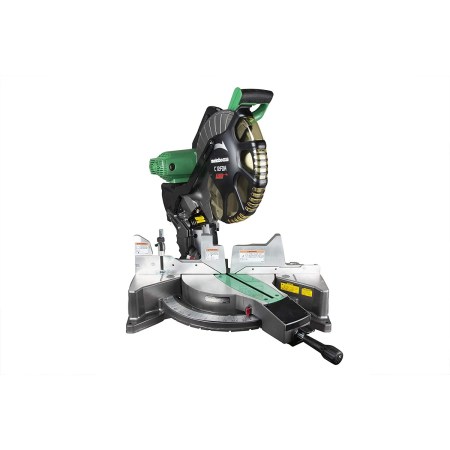We may earn revenue from the products available on this page and participate in affiliate programs. Learn More ›
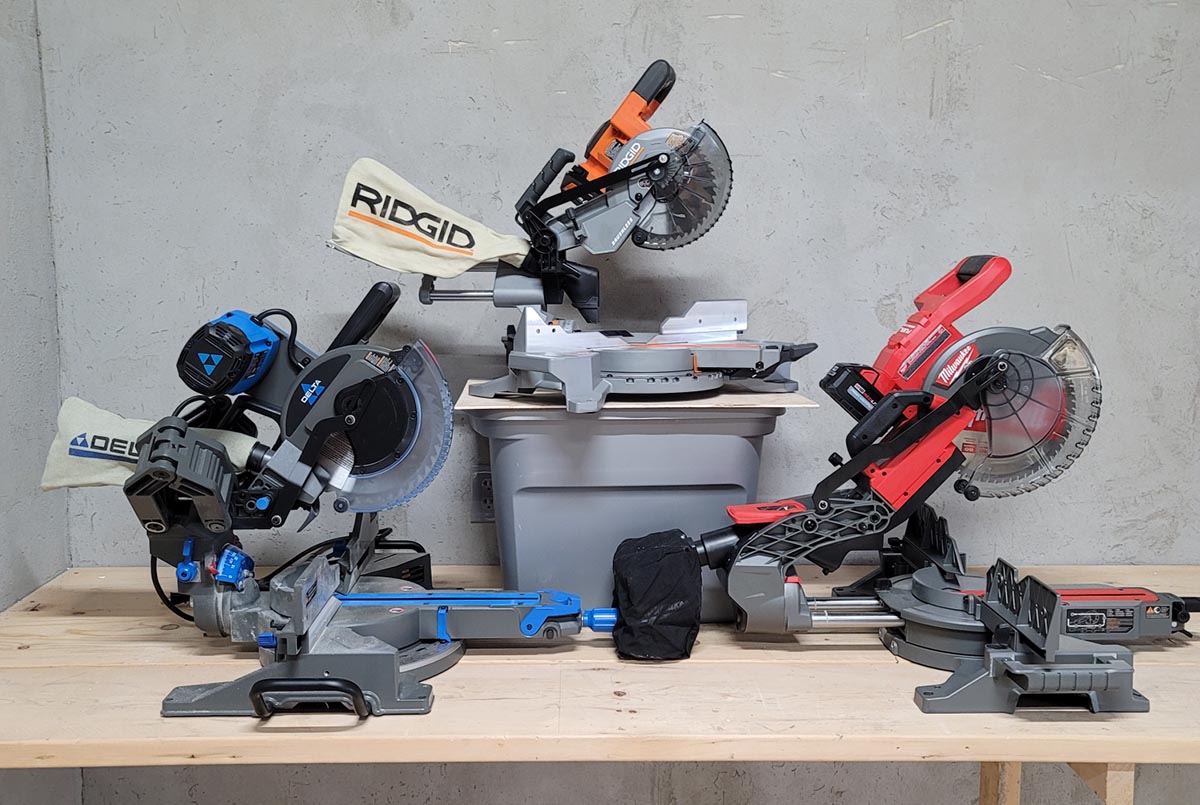
Today’s miter saws are a significant improvement over the manual miter boxes of the 1960s, having evolved into powerful tools that streamline the art of mitering, beveling, and crosscutting. That’s why we researched more than 30 models and then narrowed down our choices before choosing the highest-rated ones for testing in our own woodworking shops and on actual jobsites.
Keep reading to find out what happened in testing, and see how the following models earned a spot in our lineup of some of the best miter saws.
- BEST OVERALL: Bosch GCM12SD 12-in. Dual-Bevel Glide Miter Saw
- RUNNER-UP: DeWalt 12-in. Double-Bevel Sliding Compound Miter Saw
- BEST BANG FOR THE BUCK: Craftsman V20 Cordless 7¼-in. Sliding Miter Saw Kit
- BEST COMPACT: Ridgid 18V 7¼-in. Dual-Bevel Sliding Miter Saw
- BEST FOR WOODWORKING: Makita LS0815F 8½-in. Slide Compound Miter Saw
- BEST ZERO-CLEARANCE: Makita LS1019L 10-in. Dual-Bevel Sliding Miter Saw
- BEST CORDLESS: Milwaukee M18 FUEL 10-in. Sliding Compound Miter Saw
- BEST FOR TRIM: Delta 10-in. Dual-Bevel Sliding Compound Miter Saw
- ALSO CONSIDER: Metabo HPT 12-in. Dual Compound Miter Saw With Laser
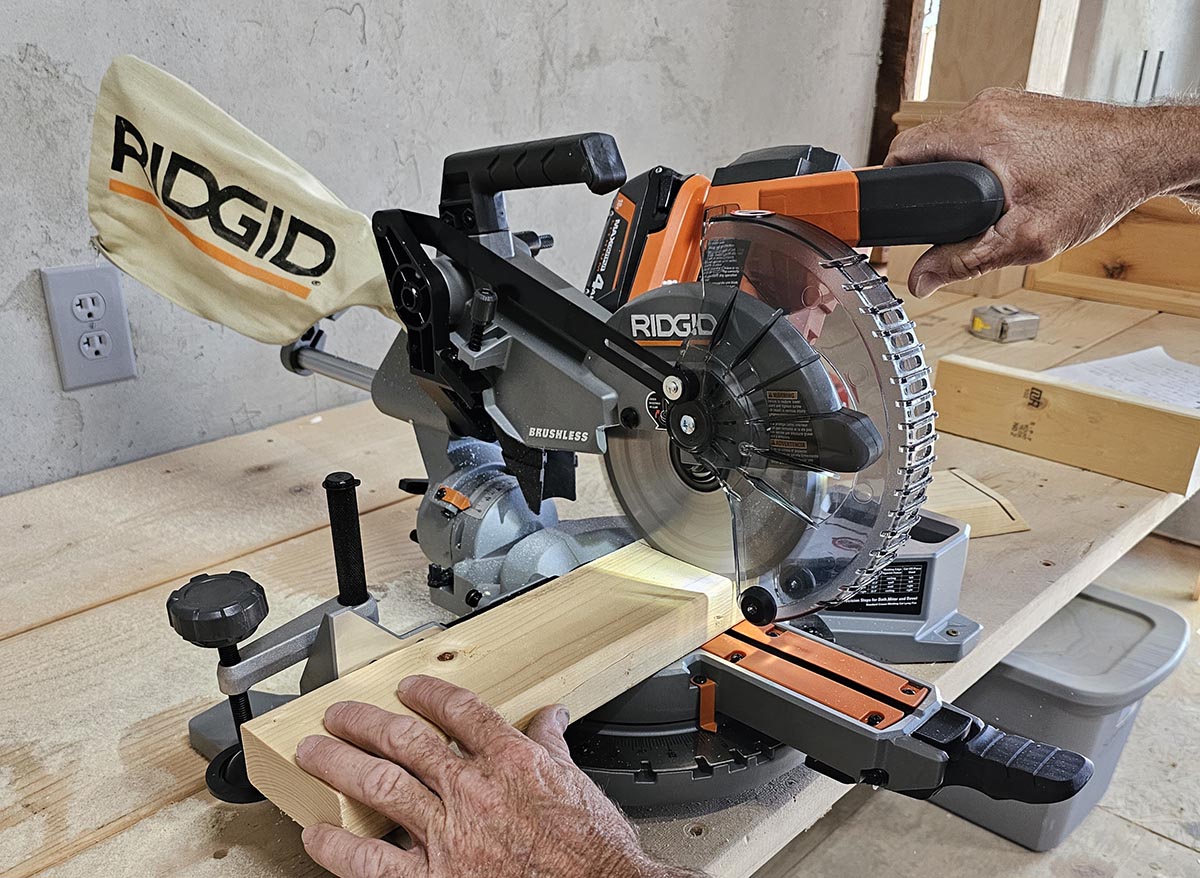
How We Tested the Best Miter Saws
Our process began with assembling each saw, some being trickier than others. We attached sharp blades, wings, knobs, and dust-collection systems, assessing the ease of setup. We then examined all features and adjustments, including miters, compound bevels, lasers, work lights, and other conveniences, making sure everything functioned properly. We also checked each miter blade’s squareness for accuracy.
Then, the real tests began. We cut a variety of materials, including 2x4s, 1x4s, base, crown, trim, and even stacked boards for an added challenge. We made dozens of cuts with each saw to see how well it stood up to repeated use. Afterward, we carefully inspected the cut pieces for precision and smoothness.
We graded each saw based on a rubric—the better it performed on a specific test, the more points it received. After our comprehensive hands-on testing, we used the scores to determine which miter saws were best suited for different users and projects.
Our Top Picks
A miter saw is an essential power tool for anyone who does carpentry work. Whether you’re a trim specialist seeking precision for intricate cuts or a carpenter tackling a range of projects, this list has a saw to meet your budget and project needs.
Best Overall
Bosch GCM12SD 12-in. Dual-Bevel Glide Miter Saw
See ItProduct Specs
- Blade size: 12 inches
- Miter and bevel? Yes, dual bevel
- Sliding? Yes
Pros
- Smooth zero-clearance arm provides ample user-friendliness
- Powerful motor provides durability and long-term usage
- Dust-collection system keeps dust and debris out of the air and workshop
- See-through safety guard integrated into the design to prevent unwanted cuts
Cons
- Does not include a light to illuminate the workspace or a laser to pinpoint cut lines
- At 65 pounds, it’s a little heavy compared with other models and difficult to carry around a shop
The Bosch GCM12SD 12-inch miter saw comes with a sliding arm that allowed us to cut boards up to 14 inches wide. The saw comes with pull-out material supports on both sides to stabilize boards up to 40 inches long, and it cuts compound bevels in both directions.
The clear saw guard on the Bosch miter saw is designed not to obstruct the user’s view of the cut, and we were able to clearly see our cutlines from start to finish. The trigger handle features an ergonomic grip that can be used by either right-handed or left-handed users just as comfortably, and it features a padded nonslip grip. Fences are adjustable, and the miter scale numbers are etched into stainless steel for durability.
During testing, we found that the Bosch saw truly does belong at the top of this list. First, it has a zero-clearance slide arm that can sit up against a wall if necessary. The smooth zero-clearance arm makes accurate cuts. Also, there wasn’t any assembly to deal with, and there are lots of additional references for roof rafters and valley cuts built in. The dust collection is outstanding, and the motor is incredibly powerful. The only qualms anyone might have with this saw is that it’s a little heavy for carrying around the shop, and there aren’t any lasers or lights.
Get the Bosch miter saw at Amazon, The Home Depot, Acme Tools, or Menards.
Runner-Up
DeWalt 12-in. Double-Bevel Sliding Compound Miter Saw
See ItProduct Specs
- Blade size: 12 inches
- Miter and bevel? Yes, dual bevel
- Sliding? Yes
Pros
- Powerful motor is ideal for heavy-duty or frequent use
- Large-capacity design makes it ideal for professional as well as DIY use
- Uses a locking lever instead of a turning knob for quick angle changes
Cons
- No laser guide integrated into the design
- Needs a lot of room for the slide rails, so it may not suit smaller workshops
Anyone looking for a miter saw that does almost everything well may want to check out the DeWalt 12-inch sliding miter saw. The saw comes with a powerful 15-amp motor, and its sliding rails allowed us to cut a board up to 16 inches wide. With its dual-compound action, there’s no need to turn a board over to cut an opposing angle; just tilt the blade arm in the other direction.
This DeWalt miter saw also features a bright LED light that illuminates the cutting field so the user can see exactly where they’re cutting, but it does not have a laser guide. For easier cleanup, it includes a collection dust bag designed to catch up to 75 percent of the dust it generates.
During testing the DeWalt saw proved to be a worthy tool. Despite not having a laser guide, the onboard LED light and powerful motor made cutting a breeze. We appreciated the large cutting capacity, though it does come at the cost of requiring a lot of room for the rails. Also, instead of a turning knob to lock the saw angle in place, this saw uses a locking lever for quick angle changes.
Get the DeWalt miter saw at Amazon, Lowe’s, Ace Hardware, or The Home Depot.
Best Bang for the Buck
Craftsman V20 Cordless 7¼-in. Sliding Miter Saw Kit
See ItProduct Specs
- Blade size: 7¼ inches
- Miter and bevel? Yes, single bevel
- Sliding? Yes
Pros
- Lightweight and compact enough to transport if necessary
- Quiet operation volume will not disturb others in a house, on a jobsite, or in a workshop
- Relatively powerful compared with comparable models
Cons
- Contains a lot of plastic pieces, so it may not provide long-term durability
- Single bevel may not be ideal for some users
The most significant benefit of the Craftsman V20 is its small footprint and lightweight design. Also, the ability for it to be used even when electricity isn’t available is a plus. Lithium-ion batteries are getting more powerful, and this miter saw can make up to 585 cuts through a 3¼-inch medium-density fiberboard on a single charge. It accepts a Craftsman 20-volt rechargeable battery, which is included along with a battery charger.
This miter saw features a powerful motor that spins the blade at a rate of 3,800 revolutions per minute, making it well suited to cutting wall studs, baseboards, and molding with ease. It also slides, making it possible to cut boards up to 8 inches wide.
We weren’t exactly sure what we’d find with the Craftsman V20 saw, mainly due to its weight—it’s just 31 pounds—and the large number of plastic pieces. But it was easy to put together, cut well, and was shockingly quiet. We could see using this saw for projects like flooring or trim work, though it did handle the construction lumber. Our only real qualms were the plastic and the single-bevel action (rather than dual).
Get the Craftsman miter saw at Amazon, Lowe’s, or Ace Hardware.
Best Compact
Ridgid 18V 7¼-in. Dual-Bevel Sliding Miter Saw
See ItProduct Specs
- Blade size: 7¼ inches
- Miter and bevel? Yes, dual bevel
- Sliding? Yes
Pros
- Cordless design allows it to be used in various locations without needing an electrical outlet
- Weighing just 24 pounds, it’s easy to carry to different locations
- Built-in LED lighting enhances cut-line visibility, improving the accuracy
- Positive bevel and miter stops at standard angles simplify cutting tasks
Cons
- Needs to be bolted down for stable operation
- Included dust-collection bag may not provide the most effective dust control
With its sturdy carry handles and a manageable weight of just 24 pounds, the Ridgid miter saw was relatively easy to transport to different worksites. And despite its compact size, this is a powerful little saw.
The most significant standout feature is its cordless design, which eliminates the need for a nearby electrical outlet and the risk of the user tripping over cords. It provides the freedom to work in various locations without being tethered to power sources. One minor drawback is the handle design. It’s more comfortable for right-hand use, and while a left-handed user can operate it, it’s a little awkward.
A 7¼-inch saw has a benefit—while it’s slightly limited to board width (we still cut 2x12s), it offers the flexibility to swap in a blade from a 7¼-inch circular saw when needed. Although not intended for heavy-duty use, the sliding arm adds versatility for longer cuts. In testing, we noticed that it was particularly well suited for cutting trim, base, crown molding, and making mitered and straight cuts on smaller boards. Although its portability is a plus, it must still be bolted down for stable operation.
We thought that the included dust-collection bag left room for improvement—it collected less than half of the sawdust and wood dust the tool generated. We solved this issue by attaching a shop-vac hose for more effective dust control. However, the saw consistently delivered clean cuts, and we were able to make repeated cuts for over an hour without the 18V 4Ah battery showing signs of depletion. On the plus side, the Ridgid comes with a bright LED light that really helps illuminate the workpiece.
This is a great little saw for remote projects and trim jobs. It won’t handle large timbers, but it’s ready to go right out of the box and makes cuts that are straight, true, and precise.
Get the Ridgid miter saw at The Home Depot.
Best for Woodworking
Makita LS0815F 8½-in. Slide Compound Miter Saw
See ItProduct Specs
- Blade size: 8½ inches
- Miter and bevel? Yes, single bevel
- Sliding? Yes
Pros
- Massive cut capacity for a smaller saw makes it ideal for professional as well as DIY use
- Doesn’t deflect while cutting for improved safety and accuracy
- Quiet compared with larger saws on the market
Cons
- Doesn’t tilt to the right, which limits its capability for some cutting tasks
- Soft start feels a bit chattery
For woodworkers needing a miter saw for the workshop or to take on a jobsite, this Makita tool doesn’t disappoint. It cuts boards up to 12 inches wide, and it features pull-out material stabilizers to support boards when cutting.
Weighing in at only 31 pounds, this miter saw is easy to transport, and it bolts to the worktable for stability. The Makita saw comes with a dust-collection port. For added safety, it features a trigger brake that stops the blade from spinning when the user releases the trigger. It also comes with a “soft start” designed to reduce movement and improve accuracy. Additionally, the saw cuts bevels in both directions.
We liked this saw’s smaller blade, as it appeared not to deflect (meaning to bend while cutting) like a 12-inch blade might. The motor was powerful enough for a smaller saw, but the cut capacity was outstanding. The soft start, on the other hand, was a little rough, giving the saw a bit of a chattery feeling until the blade sped up. Our other complaint was that the blade did not tilt to the right, limiting the saw’s capability a bit.
Get the Makita LS0815F miter saw at Amazon, The Home Depot, or Acme Tools.
Best Zero-Clearance
Makita LS1019L 10-in. Dual-Bevel Sliding Miter Saw
See ItProduct Specs
- Blade size: 10 inches
- Miter and bevel? Yes, dual bevel
- Sliding? Yes
Pros
- Powerful motor is ideal for professional as well as DIY use
- Sliding design is brilliant and user-friendly
- Lots of features and extras included with the saw
Cons
- A little complicated to set up
- An armful to move around at just under 60 pounds, though it’s slightly lighter than some models
Anyone who’s short on workspace, but still wants maximum cut capacity, may want to check out the LS1019L from Makita. This saw features a 10-inch blade, dual-bevel action, and a laser cutline for accurate cuts. The 15-amp motor has plenty of power and spins at 3,200 revolutions per minute (rpm) for cutting a variety of wood materials.
This saw has specially designed rails that come toward the user, allowing this saw to be positioned closer to a wall. These zero-clearance rails make this saw a great choice for a workshop or other areas where space is limited.
During testing, there weren’t many areas where the Makita didn’t excel. The zero-clearance arm and its action were excellent, and the saw had plenty of power. Also, the laser helps line up the cut, and the dust collection is top-notch. The only issue we found was that the saw was a little complicated to set up, and despite Makita touting that this saw is light, it’s not that light, weighing in at almost 60 pounds.
Get the Makita LS1019L miter saw at Amazon, Tractor Supply Co., The Home Depot, or Acme Tools.
Best Cordless
Milwaukee M18 FUEL 10-in. Sliding Compound Miter Saw
See ItProduct Specs
- Blade size: 10 inches
- Miter and bevel? Yes, dual bevel
- Sliding? Yes
Pros
- Cordless design frees users from the entanglements of electrical cords
- Bright and focused LED light source ensures excellent visibility
- Safety switch conveniently located next to the trigger for easy, one-handed operation
Cons
- Dust-collection bag was useless—consider connecting the dust port to a shop vacuum
The Milwaukee 10-inch miter saw is a powerful precision tool for professionals and DIY enthusiasts alike. This cordless wonder offers many remarkable features, and it consistently delivered accurate cuts on all our test materials.
Like other battery-powered tools that are overtaking the construction and remodeling industry, this miter saw’s cordless design is a game-changer. It liberates the user from the hassles of tangled electrical cords, tripping hazards, and searching for the nearest power outlet, and it provides unmatched versatility in a variety of work settings. This saw offers the flexibility to work wherever projects are set up.
The Milwaukee miter saw offers more than just cordless convenience; it’s also a powerhouse when it comes to cutting performance. It handled a wide range of cutting tasks with remarkable precision during our testing. From basic cuts to complex bevel and miter angles, this saw consistently delivered top-notch results, and the sliding arm allowed us to cut boards up to 12 inches wide.
Although the saw comes equipped with a dust-collection system, the dust bag didn’t collect much sawdust—most spewed into the air before it reached the bag. We connected the hose from our shop vacuum, and the suction from the vacuum kept more of the sawdust from becoming airborne.
The safety switch—conveniently located next to the trigger—offers effortless one-handed operation. This contributes to overall ease of use, especially during extended cutting sessions. Another standout feature is the bright LED light source. It’s not just a token addition; it’s a practical and well-designed element. It provided excellent visibility, casting a focused beam directly onto our test workpieces.
The saw made smooth, precise, and consistent cuts, and the positive stops on the miter scale and the bevel scale allowed us to change angles quickly. Similar to other top-tier miter saws we tested, this one comes with a precalibrated blade ready to start cutting right out of the box. It weighs a substantial 45 pounds, but for the best stability, it should be bolted down.
Get the Milwaukee miter saw at The Home Depot, Acme Tools, or Amazon.
Best for Trim
Delta 10-in. Dual-Bevel Sliding Compound Miter Saw
See ItProduct Specs
- Blade size: 10 inches
- Miter and bevel? Yes, dual bevel
- Sliding? Yes
Pros
- Came precalibrated and exhibited a high level of precision in hands-on testing
- Handles a wide range of miter and bevel angles for added versatility
- Features advanced positive stops for compound bevel angles for coping joints
- Padlock-capable head for locking the miter saw for safety and security
Cons
- Dust-collection bag doesn’t impress—plan on attaching the hose of a shop vacuum
- Corded model requires access to an electrical outlet, which makes it less portable
The Delta 10-inch miter saw is all about getting woodworking right with precision and efficiency. Unlike a regular saw, it can do tricky angles without a fuss, and both right-handed and left-handed folks can use it comfortably. In our tests, it didn’t miss a beat. From cutting fiddly crown molding to chunky baseboards, this saw made the cuts perfectly every time.
In testing, several things stood out on the Delta—first, adjusting it was a breeze thanks to the easy-access levers for both the miter and bevel angles. The sawdust bag didn’t work well, but it’s got a clever port that sucks up the sawdust when it’s connected to a vacuum.
This saw felt solid and was ready to go right out of the box—no fiddling with adjustments. With miter saws used for making precise cuts, such as coping angles, it’s essential to check the fence and blade for correct calibration, which we did using a speed square. Had it been out of alignment, we would have needed to make adjustments via the tool’s bevel adjustment bolt. However, the Delta came perfectly calibrated, and no adjustments were needed.
Many of the miter saws we tested came with positive stops (detents) that allowed us to quickly set the most common angles for cutting, but the Delta takes convenience a step further. This saw also features positive miter and bevel stops for inside coping joints (a 33.85-degree bevel and a 31.62-degree miter). This makes the Delta saw handy for trim and finish carpenters who regularly fit coping joints. It’s also capable of cutting boards up to 16 inches wide.
The Delta is a smart pick for pros who want an advanced trim-cutting tool that’s precise, tough, and versatile for their woodworking tasks. It is a corded model, though, so it requires access to an electrical outlet.
Get the Delta miter saw at Amazon, Lowe’s, or The Home Depot.
Also Consider
Metabo HPT 12-in. Dual Compound Miter Saw With Laser
See ItProduct Specs
- Blade size: 12 inches
- Miter and bevel? Yes, dual bevel
- Sliding? No
Pros
- Plenty of power; ideal for heavy-duty cutting tasks in workshops and on jobsites
- Laser makes it easy to line up cuts quickly
- Not terribly heavy at just under 48 pounds, so it can be transported if necessary
Cons
- Does not slide so it may not be suitable for certain projects
- Lever for adjusting the tilt is awkward
The affordable Metabo HPT 12-inch miter saw with laser guide cuts bevels in both directions and comes with a powerful 15-amp motor to boot. Thanks to the laser feature, the cutline is easy to see on the board before cutting, reducing the possibility for errors. The Metabo HPT also comes with a pivoting fence to simplify cutting crown molding.
This full-size saw comes with an elastomer-coated handle designed to reduce vibration, hand fatigue, and hand slippage. This is a nice and unexpected feature on a more affordably priced saw.
With plenty of power, the Metabo HPT miter saw can cut through just about anything carpentry-related. The laser is also a nice feature, as it makes lining up cuts quick and easy. It’s also not terribly heavy, thanks in part to the lack of slides. However, the blade on our model wasn’t square, so we had to adjust it before it would cut correctly. Also, the lever for adjusting the saw’s tilt is awkward and not intuitive.
Get the Metabo HPT miter saw at Amazon, Ace Hardware, or Menards.
Jump to Our Top Picks
What to Consider When Choosing a Miter Saw
The type of woodworking projects a user intends to undertake will determine the features needed in a miter saw. Someone who only wants a miter saw to make crosscuts on wood flooring strips won’t need the extra features a professional trim carpenter needs to cut crown molding. There are several features to consider when choosing a miter saw, starting with the type.
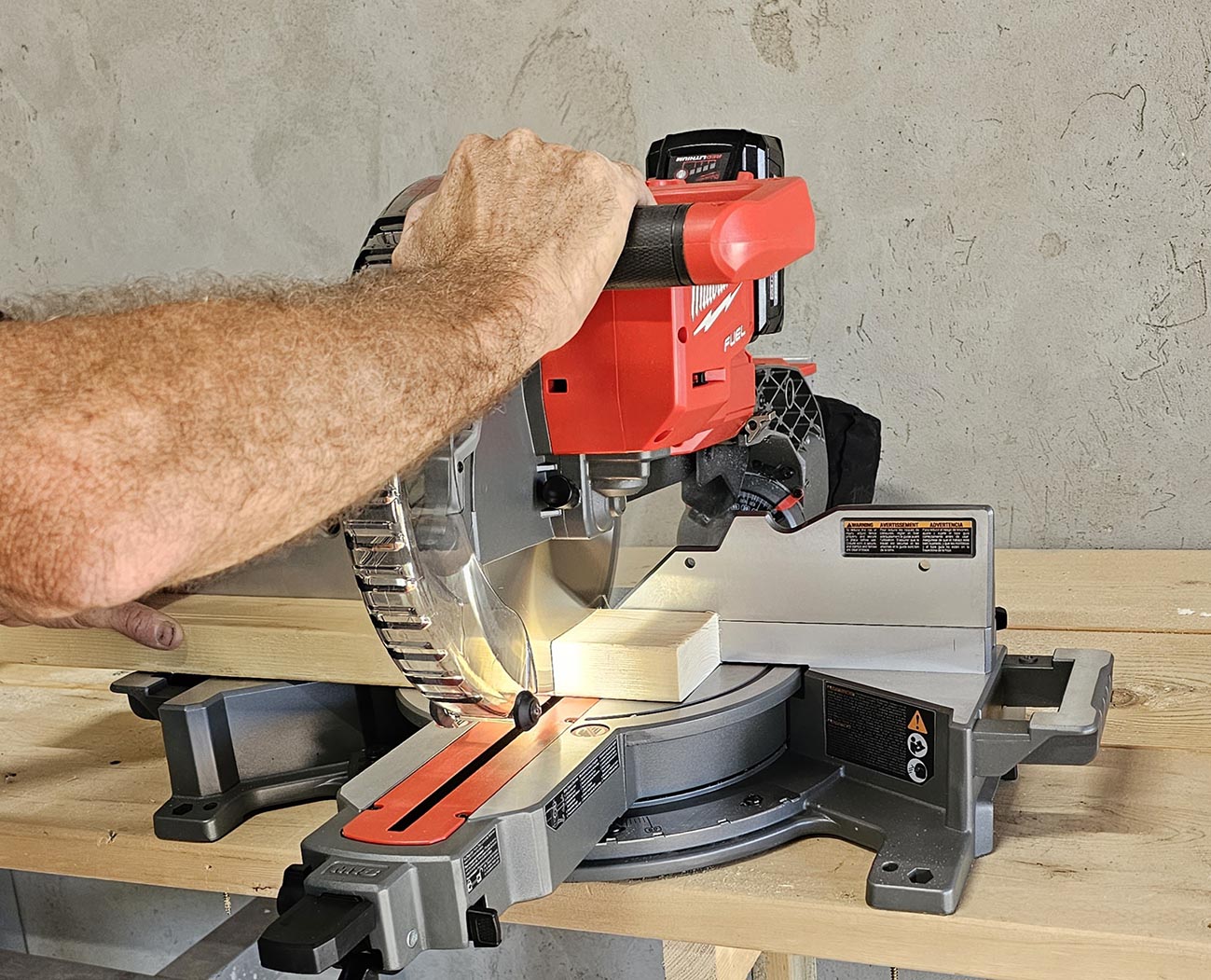
Types of Miter Saws
All miter saws feature a circular blade encased in a swing arm that pivots from side to side to make crosscuts on narrow strips of wood (5 to 18 inches wide, depending on the saw). However, one saw doesn’t fit all types of projects, so individual woodworking needs will determine which saw is right. Depending on quality and features, miter saws can start at around $175 and run up to $1,000 or more. The following are the most common types of miter saws:
- Standard miter saw: This simplest of all miter saws is sometimes called a “chop saw” because the swing arm pivots to the appropriate angle and then chops through the material. These simple power miter saws only make miter cuts, so they’re not as popular as some other types of saws.
- Single-bevel compound miter saw: In addition to cutting angles, the swing arm on a single-bevel compound miter saw tilts in one direction (typically to the left) to make miter or bevel cuts. This comes in handy for tasks such as cutting crown molding or certain types of roof rafters. Many miter saws are compound miter saws.
- Dual-bevel compound miter saw: A dual-bevel compound miter saw also cuts bevels, but unlike a single-bevel compound miter saw, the swing arm tilts in both directions. This is strictly a convenience and a time-saver—a single compound miter saw can still make the same cuts, but the user has to turn the board over to cut a bevel in the opposite direction. The dual-bevel ability saves that step.
- Compound sliding miter saw: Sliding rails on a compound miter saw allow the user to cut wider boards. Nonsliding miter saws cut boards a few inches narrower than their blade diameter, so a 10-inch miter saw will cut a board up to 6 inches wide. If cutting a wider board, the user will have to turn the board over to finish cutting through it.
A compound sliding miter saw is the best type of miter saw for cutting wide boards because users can pull the saw’s motorhead toward themselves, lower the head, activate the motor, and push it through the board.
Depending on the model, a sliding miter saw can handle boards from 10 to 18 inches wide, and it can be either a single-bevel compound or dual-bevel compound miter saw. Some of the best compound miter saws also feature zero-clearance arms, which allow the saw to sit close to a wall without limiting the blade’s travel.
Size and Intended Use
Miter saws are labeled by the blade size they can accept. In general, the larger the blade, the larger the board the saw will cut. Not everyone needs the largest blade size—some prefer a tool with a smaller blade because those tools are typically lighter in weight and simpler to move (and often more accurate). A few off-sizes exist, but the most common miter saw blade sizes are 7¼, 8½, 10, and 12 inches.
- 7¼-inch and 8½-inch miter saws: Handy for around-the-house cutting, these saws will make a 90-degree cut on a 2×4 and a 45-degree cut on a 1×2.
- 10-inch miter saw: A 10-inch miter saw will make a 90-degree cut on a 2×6 and a 45-degree cut on a 2×4.
- 12-inch miter saw: The largest size used by DIYers and most builders, a 12-inch miter saw will make a 90-degree cut on a 2×8 and a 45-degree cut on a 2×6.
Any of the above miter saws can cut wider boards if they’re equipped with a sliding arm. For example, a 10-inch miter saw with a 6-inch sliding arm can make a 90-degree cut on a 2×12.
Keep in mind that 10- and 12-inch blades often suffer from a bit of deflection. Deflection is when the blade’s path wobbles a bit during cutting. While it’s not usually an issue, discerning woodworkers and high-end finish carpenters may choose a saw that minimizes deflection.
Corded vs. Cordless
Until a few years ago, all miter saws were corded, and most still are, but these cords limit where the saw can operate. Cordless miter saws are the new kids on the block, and they operate on rechargeable lithium-ion batteries. Battery runtime depends on the number of cuts and how thick the wood is, but on average cordless miter saws can make 150 to 275 cuts on a single battery charge.
Motor Power
The more power the saw’s motor has (measured in amperes), the longer the user can cut boards without the risk of the saw overheating. Typical miter saw motor sizes are 10-amp, 12-amp, and 15-amp.
The larger motors will also generate enough blade-spinning force for cutting through thick, dense material. For example, for those only cutting through pine boards, a 10-amp miter saw will likely offer more than enough power. However, a more powerful motor may be necessary for those who need to make repetitive cuts through fiber cement siding or oak stair treads.
Safety
A miter saw isn’t the most dangerous saw in the workshop, but it can still cause injury if it’s misused or if it doesn’t come with safety features. The following safety features are standard on most miter saws.
- Blade guard: This is a clear cover that encases the spinning miter blade. When the user lowers the blade to cut, the guard rotates out of the way. When the user lifts the blade, the guard rotates back over the blade to cover it.
- Trigger brake: Not all miter saws have a brake. If they do, the brake stops the blade from spinning when the user releases the trigger.
- Lockout button: If the saw has a lockout button, the blade won’t spin when the user pulls the trigger unless the lockout button is also depressed. This double-safety measure prevents unintentional cuts.
- Clamps: Most miter saws come with a safety clamp to help hold the material in place while the user is cutting. This keeps a board from slipping, which reduces the risk of the user grabbing it and inadvertently touching the spinning blade.
- Dust collection: Like all power saws, miter saws create a lot of fine dust that can irritate the eyes or lungs. If the saw has a dust-collection port, a user can attach a standard shop-type vacuum hose, and the suction from the vacuum will remove most of the dust before it becomes airborne.
Additional Features
Miter saws are versatile, and some come with additional features that expand on their use. Some accessories come built into the saw, and some can usually be purchased separately if the user desires. Here are some common extra features of miter saws:
- Laser guide: Some miter saws have laser guides that mark a red or green line across the wood where the blade will cut. This is an excellent feature for DIYers and beginners to ensure the board is correctly positioned before cutting.
- Depth stop: A miter saw that comes with a depth stop allows the user to set the depth of the cut—similar to a radial arm saw. This allows the user to cut a groove in the material without cutting all the way through.
- Sliding fences: Sliding fences are built into some miter saws, and they pull out on both sides to allow the user to position the material securely along the fence.
- Flip fences: Flip fences come with locking stops, and the user can lock two or more stops on the fence and simply flip them up and out of the way to cut a different length. Flip fences are handy when the user needs to go back and forth between two or more lengths when cutting boards.
- Nonslip grip: Hot summer days can result in slippery grips on a miter saw handle. Some manufacturers now offer padded nonslip grips to reduce hand fatigue and allow for a better grasp.
- Dust collection: Miter saws tend to kick up sawdust, particularly when operated inside a workshop. To remedy this, two types of dust collection are available for miter saws. The first is a small bag designed to collect some of the dust that blows into it naturally as it comes off the blade. The second (and better) option is a dust-collection port that connects to the hose of a shop-type vacuum.
- Stand: Many miter saws come with holes that allow the user to bolt them to the workshop table for stability, but a few come with miter saw stands that hold the saw securely when cutting.
FAQs
Over the past few years, the miter saw has almost replaced the radial arm saw in workshops and jobsites because it’s quicker to adjust angles and it cuts precise degrees. Anyone cutting angles, such as for wood trim, may find that the miter saw quickly becomes their favorite power tool in the workshop. For those thinking about buying their first miter saw, here are some answers to a few common questions.
Q. What is the main use of a miter saw?
The main use of a miter saw is to cut precise angles on the ends of boards, trim, and molding. Though miter saws are perfect for wood, some options are also ideal for plastic, masonry, and metal.
Q. What is the difference between a compound and a sliding miter saw?
A compound miter saw cuts bevels in addition to angles, whereas a sliding miter saw comes with a cutting arm the user can pull to cut wider boards. A miter saw can be both sliding and compound.
Q. Can you use a miter saw to rip boards?
No. Ripping is the process of cutting boards lengthwise and is usually done on a table saw. A miter saw makes crosscuts and angled cuts. Those who are interested in rip cuts should consider a circular or table saw that has a rip guide and/or fence.
Q. How can a beginner learn how to use a miter saw?
The best way for a beginner to learn how to use a miter saw is by purchasing a miter saw that comes with safety features and reading the operating manual entirely before using the saw. It may also be beneficial for a beginner to watch someone else use a miter saw—either in person or by watching online instructional videos.
Why Trust Bob Vila
Bob Vila has been America’s Handyman since 1979. As the host of beloved and groundbreaking TV series including “This Old House” and “Bob Vila’s Home Again,” he popularized and became synonymous with “do-it-yourself” home improvement.
Over the course of his decades-long career, Bob Vila has helped millions of people build, renovate, repair, and live better each day—a tradition that continues today with expert yet accessible home advice. The Bob Vila team distills need-to-know information into project tutorials, maintenance guides, tool 101s, and more. These home and garden experts then thoroughly research, vet, and recommend products that support homeowners, renters, DIYers, and professionals in their to-do lists.
Meet the Testers
Tom Scalisi is a full-time DIY and construction writer for many of the largest websites in the industry, including BobVila.com, This Old House, Family Handyman, and Forbes. He also owns and operates a pest control blog, RiddaBugs.com. He spent years working in the trades and industrial building maintenance.
Glenda Taylor is a product tester and writer specializing in the construction, remodeling, and real estate industries. She and her husband own a general contracting company, and Taylor is experienced in both residential and commercial building applications. She tests a wide range of power tools as well as other home improvement, household, and lawn-and-garden products.
